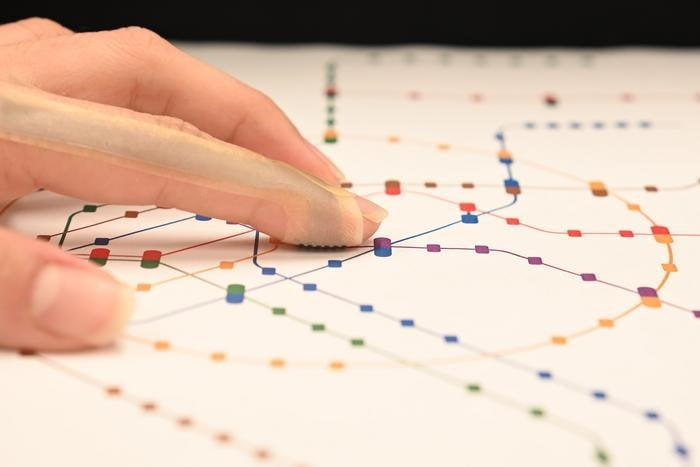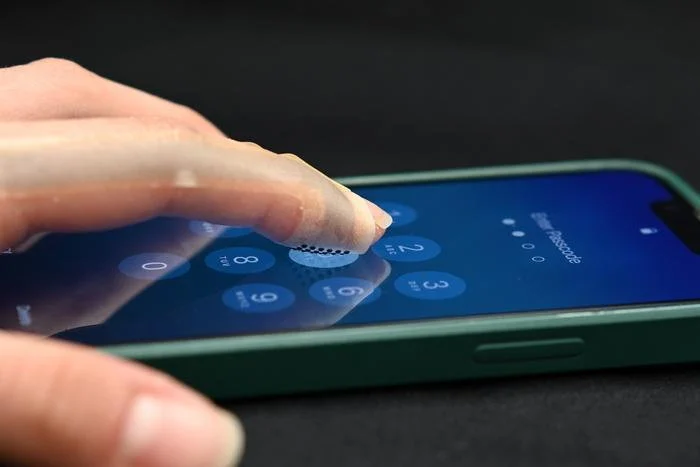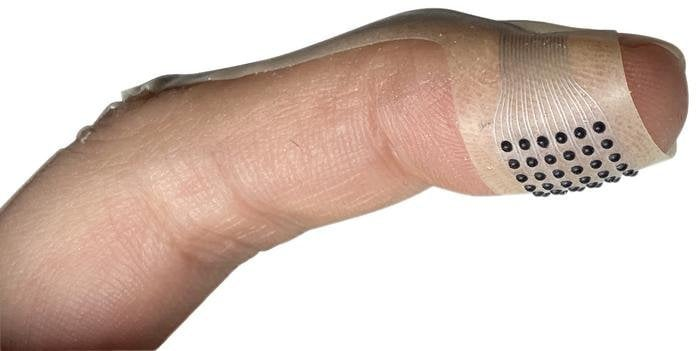
(Sylvia Tan/Northwestern University via SWNS)
By Stephen Beech
A new bandage-like device allows people to "feel" textures through touchscreens.
The soft, stretchable material wraps around a fingertip to give digital touch the same realism people now expect from today’s screens and speakers.
It lets users feel the digital world at "human resolution" - meaning it accurately matches the sensing abilities of the human fingertip, according to American engineers at Northwestern University in Illinois.
They say their ultra-thin, lightweight, flexible, wearable device - called VoxeLite - recreates touch sensations with the same clarity, detail and speed that skin naturally detects.
It could transform how people interact with digital environments - including more immersive virtual reality systems, assistive technologies for people with vision impairments, and enhanced online shopping, according to the study published in the journal Science Advances.
Doctoral student Sylvia Tan, who led the study said: “Touch is the last major sense without a true digital interface.
“We have technologies that make things look and sound real.
"Now, we want to make textures and tactile sensations feel real.
"Our device is moving the field toward that goal.
"We also designed it to be comfortable, so people can wear it for long periods of time without needing to remove it to perform other tasks.
"It’s like how people wear glasses all day and don’t even think about them.”

(Sylvia Tan/Northwestern University via SWNS)
Study senior author Dr. Edward Colgate said: “This work represents a major scientific breakthrough in the field of haptics by introducing, for the first time, a technology that achieves ‘human resolution.
“It has the ability to present haptic information to the skin with both the spatial and temporal resolution of the sensory system.”
Despite decades of progress in high-definition video and true-to-life audio, the research team says digital touch has stubbornly lagged behind.
Today’s haptic feedback - mostly simple smartphone vibrations - cannot convey the rich, detailed information the fingertips naturally perceive.
That is partially because the skin’s spatial and temporal resolution is notoriously difficult to simulate, according to the engineers.
Dr. Colgate said: “Think of very old motion pictures when the number of frames per second was really low, so movements looked jerky.
"That’s due to low temporal resolution.
“Or think of early computer displays where images were pixelated. That’s low spatial resolution.
"Nowadays, both problems are solved for graphical displays.
"For tactile displays, however, they have been far from solved.
"In fact, very few researchers have even attempted to tackle both of them together.”
He says VoxeLite features an array of tiny, individually controlled nodes embedded into a paper-thin, stretchable sheet of latex.
The soft nodes function like pixels of touch, each capable of pressing into the skin at high speeds and in precise patterns.
Each node comprises a soft rubber dome, conductive outer layer and hidden inner electrode.
When a slight voltage is applied, it generates electroadhesion - the same principle that causes a balloon to stick to a wall after being rubbed.
In their previously developed TanvasTouch technology, Dr. Colgate and his colleagues harnessed electroadhesion to modulate friction between a fingertip and a smooth touchscreen surface.
In those devices, an applied electric field alters friction to create the illusion of texture, but it does not involve any moving parts.
Dr. Colgate says the new technology applies electrostatic forces in a precise, controlled way to make each tiny node “grip” a surface and tilt to press into skin.
That generates a highly localized mechanical force, so each “pixel” of touch pushes the skin on a fingertip.

(Sylvia Tan/Northwestern University via SWNS)
Higher voltages increase friction during movement, producing more pronounced tactile cues to simulate the feeling of a rough surface.
But lower voltages create less friction and, therefore, the sensation of a slipperier surface.
Dr. Colgate said: “When swiped across an electrically grounded surface, the device controls the friction on each node, leading to controllable indentation on the skin.
“Past attempts to generate haptic effects have been big, unwieldy, complex devices. VoxeLite weighs less than a gram.”
To create the human-resolution sensations, the team packed the nodes closely together.
In the densest version of the device, nodes are spaced about one millimeter apart.
Tan said: “The density of the nodes really matters for matching human acuity.
“The nodes need to be far enough apart that your body can tell them apart.
"If two nodes are less than one millimeter apart, your fingertips only sense one node instead of two.
"But if nodes are too far apart, they cannot recreate fine details.
"To make sensations that feel real, we wanted to match that human acuity.”
She says VoxeLite operates in two modes: active and passive.
In active mode, the device generates virtual tactile sensations by rapidly tilting and indenting individual nodes as a user moves across a smooth surface, such as the screen of a smartphone or tablet.
The nodes can move up to 800 times per second, covering nearly the full frequency range of human touch receptors.
In a series of experiments, study participants wearing the device "accurately and reliably" recognized virtual textures, patterns and directional cues.
People wearing VoxeLite identified those directions patterns - up, down, left and right - with up to 87% accuracy.

(Sylvia Tan/Northwestern University via SWNS)
They also identified real fabrics, including leather, corduroy and terry cloth, with 81% accuracy.
In passive mode, the device essentially disappears.
Because it is extremely thin, soft and conforms to the skin, VoxeLite does not interfere with real-world tasks or block the natural sense of touch.
Then, wearers can move seamlessly between real and digital experiences.
The team believe that in future the technology can be paired with smartphones and tablets.
Just like earbuds use Bluetooth to interact with our devices, VoxeLite could someday perhaps sync with devices to transform flat, smooth screens into textured interfaces.
That potentially could lead to more lifelike online shopping experiences, where shoppers can feel textiles and fabrics before making a purchase.
Tan added: “What makes this most exciting is combining spatial and temporal resolution with wearability.
“People tend to focus on one of these three aspects because each one is such a difficult challenge.
"Our lab already solved temporal resolution with electroadhesion.
"Then, my challenge was to make it spatially distributed and wearable. It did take a while to get here.
"Now, we’re running studies to understand how humans actually receive and perceive this tactile information.”
























(0) comments
Welcome to the discussion.
Log In
Keep it Clean. Please avoid obscene, vulgar, lewd, racist or sexually-oriented language.
PLEASE TURN OFF YOUR CAPS LOCK.
Don't Threaten. Threats of harming another person will not be tolerated.
Be Truthful. Don't knowingly lie about anyone or anything.
Be Nice. No racism, sexism or any sort of -ism that is degrading to another person.
Be Proactive. Use the 'Report' link on each comment to let us know of abusive posts.
Share with Us. We'd love to hear eyewitness accounts, the history behind an article.